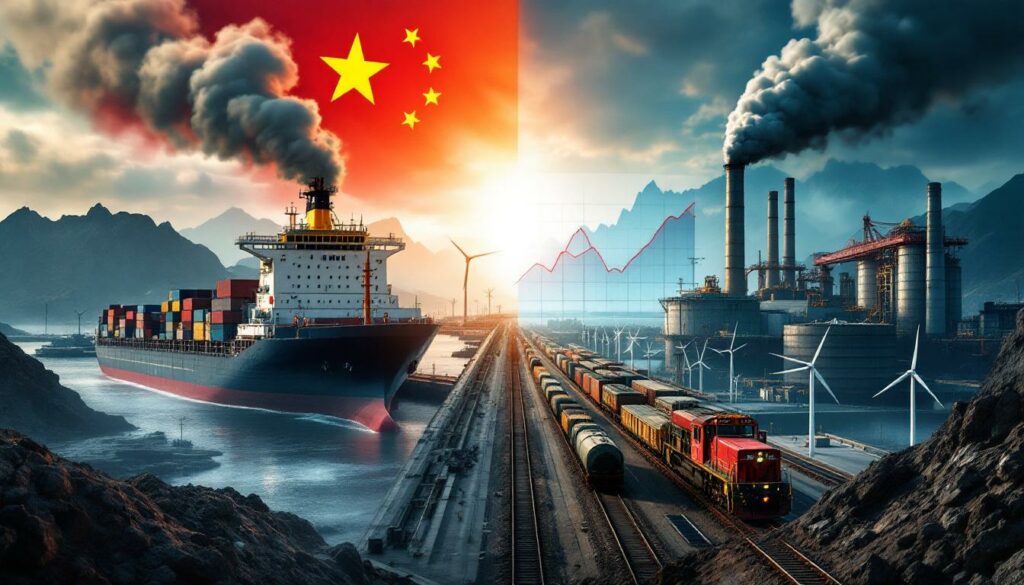Understanding China's Mixed Economic Signals
China's economic indicators are presenting a paradoxical picture in 2025, with key commodity sectors showing contradictory trends that have left analysts puzzled. These contradictions – particularly evident in the steel, iron ore, coal, and power generation sectors – reflect a complex interplay of economic challenges, strategic policy decisions, and market positioning.
The most notable contradictions appear in the steel-iron ore relationship and the coal-power generation dynamic. While steel production has declined significantly, iron ore imports have surprisingly strengthened. Similarly, coal production has increased despite reduced thermal power generation. These divergent trends create a complex puzzle for investors, analysts, and policymakers attempting to understand China's true economic trajectory.
As Clyde Russell, a Reuters columnist, notes: "Part of decoding the mixed signals is working out whether numbers are long-term trends or short-term factors." These contradictions have significant implications for global commodity markets, given China's dominant position as the world's largest consumer of industrial raw materials.
How Do Steel Production and Iron Ore Imports Tell Different Stories?
Declining Steel Output Signals Economic Challenges
China's steel production has shown consistent decline throughout the first half of 2025, pointing to underlying economic challenges. June steel output reached 83.18 million metric tons, representing a 9.2% year-on-year drop – the largest monthly decline since August. This figure also represents a 3.9% decrease from May production levels.
The first half of 2025 saw cumulative steel production fall to 514.83 million tons, a 3% decline compared to the same period in 2024. This persistent downward trend in steel output serves as a concerning indicator for China's broader economic health, particularly in construction and manufacturing sectors.
Surprisingly Strong Iron Ore Import Data
In stark contrast to falling steel production, China's iron ore imports have shown remarkable strength. June imports jumped 8% month-on-month to 105.95 million tons, representing the highest monthly import volume in 2025. While first-half imports did decline 3% to 592.21 million tons compared to 2024, the recent surge has puzzled market observers.
This contradiction is particularly significant considering China accounts for approximately 75% of global seaborne iron ore demand trends, making its import behavior a critical factor for global mining companies and commodity markets.
Reconciling the Contradiction
Several factors help explain the apparent disconnect between declining steel production and rising iron ore imports:
-
Price-driven purchasing strategies: Chinese steel mills appear to be taking advantage of relatively lower iron ore prices, which fell to $93.35 per ton on July 1 before rebounding to $97.95 by mid-July.
-
Strategic inventory management: Port stockpiles stood at 131.9 million tons in mid-July, down from 150.02 million tons a year earlier, suggesting mills may be rebuilding inventories after earlier drawdowns.
-
Quality considerations: Imported ore typically offers higher iron content than domestic sources, making it more efficient for steel production despite higher costs.
-
Positioning for stimulus effects: Mills may be preparing for anticipated demand increases following government stimulus measures targeted at infrastructure and manufacturing.
Market Insight: The disconnect between steel output and iron ore imports often serves as a leading indicator of changing market expectations. Current patterns suggest steel producers are positioning for potential demand recovery while managing near-term production cuts.
What's Behind China's Paradoxical Coal and Power Generation Data?
Robust Coal Production Despite Reduced Thermal Power
Another puzzling contradiction appears in China's energy sector data. The country reported a 5% increase in first-half coal output to 2.4 billion tons, while thermal power generation decreased by 2.4% during the same period. This contradiction presents an economic puzzle that requires deeper analysis.
Overall power generation did increase slightly by 0.8%, despite the thermal power decline and a 2.9% drop in hydropower generation. This suggests significant growth in other power sources, particularly renewables, which have seen accelerated deployment in recent years.
Strategic Reasons for Increased Coal Production
China's decision to boost coal production while reducing its use in power generation serves several strategic objectives:
-
Domestic price control measures: Coal prices at Qinhuangdao, a key benchmark, dropped to a four-year low of 610 yuan ($84.96) in June – a 20% decline from January's high of 775 yuan. This price reduction helps control electricity costs for industrial users.
-
Energy security prioritization: By increasing domestic coal output while reducing imports, China strengthens its energy independence amid ongoing global coal supply challenges.
-
Supporting manufacturing competitiveness: Lower energy costs provide a competitive advantage for China's export-oriented manufacturing sector, which continues to face international headwinds.
-
Strategic stockpiling: Some of the production surplus may be directed toward strategic reserves rather than immediate consumption.
Shift in Energy Mix Dynamics
The data also reveals an accelerating transition in China's energy landscape:
- Wind and solar deployment are increasing at record rates
- Nuclear power contribution is gradually expanding
- Energy efficiency improvements are reducing coal requirements per unit of industrial output
- Regional differences show coastal provinces transitioning faster than interior regions
These shifts have significant implications for global seaborne coal markets, particularly for major exporters like Australia and Indonesia. As China's domestic production increases and thermal power generation decreases, import demand for coal may continue to weaken.
How Are Other Industrial Materials Performing?
Mixed Performance in Construction-Related Materials
Beyond steel, iron ore, and coal, other industrial materials show similarly divergent performance patterns that provide further insights into China's economic situation:
- Aluminum production increased 3.4% year-on-year in June, with first-half output up 3.3%
- Cement production declined approximately 5% during June
- Glass production also fell by about 5% in the same period
This divergence between aluminum (primarily used in manufacturing, transportation, and consumer goods) and construction materials like cement and glass further confirms the uneven nature of China's economic challenges.
What These Contradictions Reveal About China's Economy
The mixed performance across industrial materials provides valuable insights into China's current economic conditions:
-
Construction sector struggles persist: The significant drops in cement and glass production confirm ongoing challenges in the residential construction and property sectors.
-
Manufacturing resilience amid challenges: Rising aluminum output suggests manufacturing sectors remain relatively stronger despite broader economic headwinds.
-
Government stimulus limitations: Current stimulus measures appear insufficient to revive construction activity, with targeted support instead focusing on high-tech manufacturing and infrastructure.
-
Structural transition continues: China's long-term economic restructuring away from property-led growth toward higher-value manufacturing and services appears to be accelerating.
Analyst Perspective: The divergence between construction materials and industrial metals highlights China's ongoing economic transition. While traditional property-led growth models struggle, sectors aligned with China's industrial policy priorities continue to receive support.
What Are the Market Implications of China's Mixed Data?
Iron Ore Price Movements and Outlook
Iron ore prices have shown notable volatility in 2025, reflecting the market's uncertainty about China's true demand trajectory:
- Prices recently recovered to $97.95 per ton by mid-July
- This represents a decline from the 2025 high of $107.81 reached in February
- Prices hit a low of $93.35 on July 1 before rebounding
- Market sentiment has improved on optimism about second-half demand from stimulus measures
This price volatility reflects both the reality of reduced steel production and speculative positioning based on expectations of future stimulus effects. For major iron ore producers like Rio Tinto, BHP, and Vale, these iron ore price decline trends have significant revenue implications.
Steel Production Forecasts
China's steel sector faces several constraints that will likely shape production in the second half of 2025:
-
Production cap pressures: China maintains an informal annual production cap of approximately 1 billion tons, meaning second-half production would need to remain below first-half levels (514.83 million tons).
-
Profitability challenges: Chinese steel mills have faced margin compression as steel prices have not kept pace with earlier iron ore cost increases.
-
Environmental restrictions: Seasonal production restrictions to reduce pollution, particularly in northern provinces during winter heating season, may further constrain output.
-
Export limitations: China has implemented various export restrictions to prioritize domestic supply, limiting the ability of producers to offset weak domestic demand with exports.
These factors suggest continued pressure on steel prices and production volumes through the remainder of 2025, with potential implications for global steel trade flows.
Global Commodity Market Effects
China's contradictory commodity data creates ripple effects throughout global markets:
- Downward pressure on seaborne coal prices as China reduces imports while increasing domestic production
- Selective strength in iron ore markets despite steel production declines
- Mixed outlook for industrial metals based on their exposure to construction versus manufacturing sectors
- Supply chain reconfiguration as exporters adjust to changing Chinese demand patterns
For commodity exporters like Australia, Brazil, Indonesia, and Russia, these shifts require strategic repositioning and potentially difficult adjustments to changing demand patterns.
How Should Investors Interpret China's Commodity Contradictions?
Short-Term vs. Long-Term Trends
Investors face the challenge of distinguishing between temporary fluctuations and structural shifts in China's commodity landscape:
- Cyclical factors include seasonal construction patterns, inventory cycles, and price-driven purchasing behavior
- Structural changes reflect China's economic transition, environmental policies, and changing global trade relationships
- Policy interventions create additional complexity through targeted stimulus measures and strategic commodity purchasing
Understanding which category each data point belongs to is essential for developing effective investment strategies in China-exposed commodity markets.
Key Metrics to Monitor
Savvy investors should focus on several critical indicators beyond headline production and import figures:
- Iron ore port inventory levels and their rate of change
- Steel capacity utilization rates across different provinces and product categories
- Coal-to-power efficiency ratios to understand changing energy dynamics
- Construction sector activity indicators such as property sales, land purchases, and new project starts
- Policy announcements related to infrastructure spending and environmental restrictions
These indicators provide early signals of changing trends and can help investors position ahead of broader market recognition.
Strategic Positioning for Different Commodity Segments
Different commodities require tailored approaches based on their unique exposure to China's economic crosscurrents:
-
Iron ore producers: Focus on quality differentiation and operational flexibility to manage potential demand volatility
-
Steel industry participants: Prepare for potential consolidation as the government encourages higher efficiency and environmental performance
-
Coal market participants: Adjust to a gradually declining Chinese import market while monitoring domestic production policies
-
Construction materials suppliers: Remain cautious about near-term recovery prospects while positioning for eventual policy support
Investment Insight: The most successful commodity investors in the current environment will be those who can separate signal from noise in China's contradictory data, focusing on structural trends while capitalizing on cyclical opportunities.
FAQ: China's Commodity Market Contradictions
Why is China producing more coal while using less for power generation?
China's seemingly contradictory approach to coal serves several strategic objectives:
-
Price control strategy: By increasing domestic supply, China has successfully driven coal prices to four-year lows, reducing input costs for power generation and industrial users.
-
Manufacturing competitiveness support: Lower energy costs help maintain the competitiveness of China's export-oriented manufacturing sector amid global economic headwinds.
-
Reduced import dependency: Increasing domestic production while reducing consumption allows China to minimize coal imports, improving energy security and trade balances.
-
Gradual energy transition: China continues to expand renewable capacity while maintaining coal as a reliability backstop, creating temporary production/consumption mismatches.
What explains the disconnect between steel production and iron ore imports?
Several factors help reconcile the apparent contradiction between falling steel output and rising iron ore imports:
-
Inventory cycle management: Mills may be rebuilding depleted iron ore inventories after earlier drawdowns.
-
Strategic purchasing during price dips: Chinese buyers often increase purchases when prices fall below psychological thresholds.
-
Positioning for potential demand recovery: Mills may be preparing for anticipated infrastructure stimulus effects in the second half of 2025.
-
Quality differences in domestic vs. imported ore: Imported ore typically has higher iron content, requiring less volume per ton of steel produced.
How might China's stimulus measures affect commodity markets in the second half of 2025?
China's approach to economic stimulus will likely have differentiated effects across commodity sectors:
-
Targeted infrastructure spending will selectively boost demand for steel, cement, and copper in specific project categories (particularly energy, transportation, and water management).
-
Consumer demand recovery initiatives may benefit aluminum and other metals used in consumer goods and packaging.
-
Manufacturing sector support mechanisms could stabilize industrial metals demand even if property construction remains weak.
-
Regional development priorities will create geographically uneven commodity demand patterns, with western provinces seeing stronger growth.
What are the implications for global commodity exporters?
The mixed signals in China's commodity data create a complex outlook for major exporters:
-
Iron ore producers (Australia, Brazil) may see sustained import volumes despite steel production weakness, though price volatility will likely continue.
-
Coal exporters (Indonesia, Australia) face declining Chinese demand as domestic production increases and thermal power generation decreases.
-
Base metal suppliers will experience divergent outcomes based on each metal's exposure to construction versus manufacturing sectors.
-
Agricultural commodity exporters may benefit from China's efforts to ensure food security through increased imports of soybeans, corn, and wheat.
Further Exploration:
Readers interested in learning more about China's commodity markets can also explore iron ore forecast insights and monitor BHP's strategic pivot as a barometer for how major producers are responding to these mixed signals from China's markets.
Searching for the Next Major Mineral Discovery?
Stay ahead of the market with Discovery Alert's proprietary Discovery IQ model, which instantly notifies investors of significant ASX mineral discoveries and transforms complex data into actionable insights. Understand why major discoveries can generate substantial returns by visiting Discovery Alert's dedicated discoveries page and begin your 30-day free trial today.




